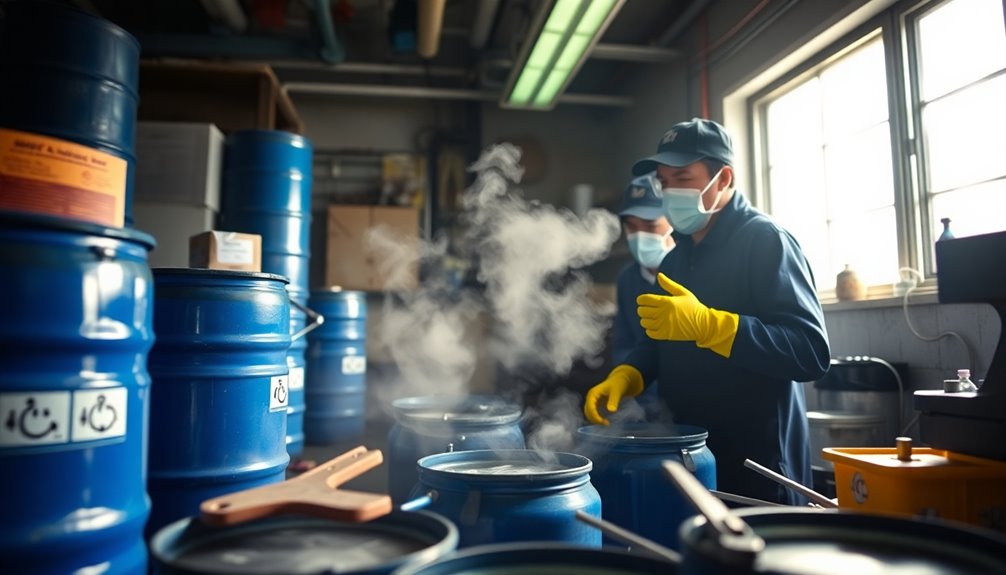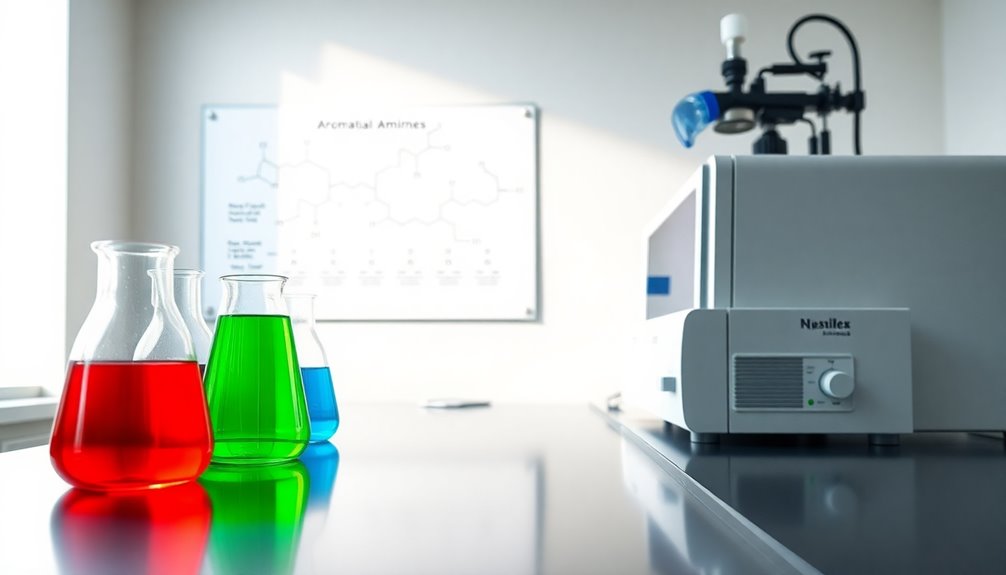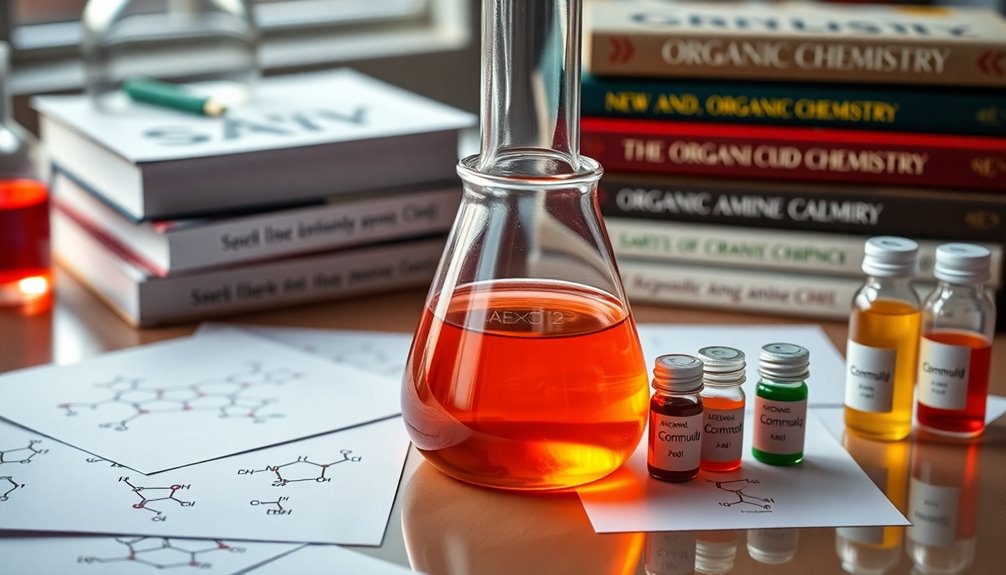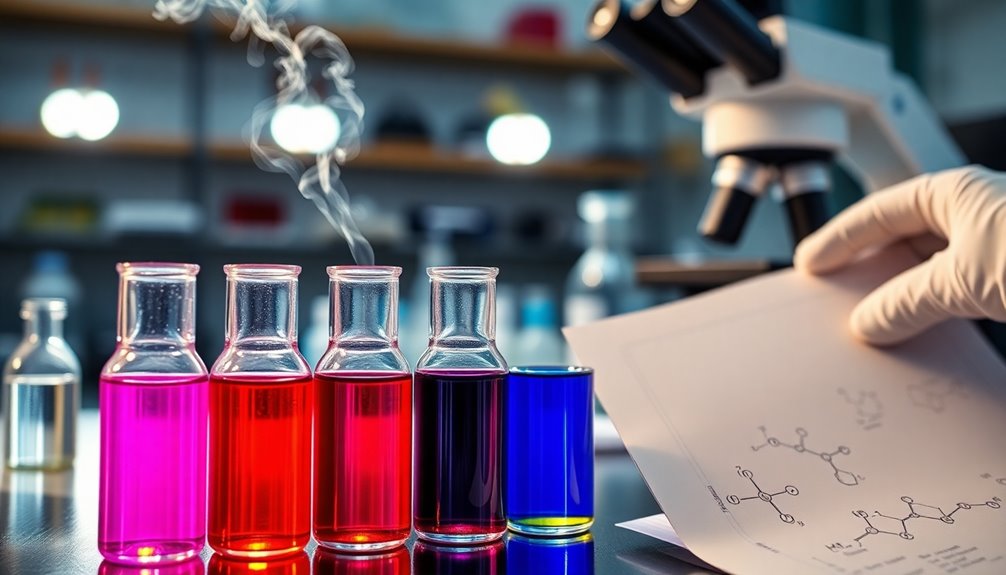You'll find aromatic amines in many everyday products and industries. They're commonly used in dyes, textiles, and pharmaceuticals, often as by-products in manufacturing processes. You can also encounter them in the environment, especially from diesel exhaust and combustion of organic materials. High-heat cooking methods, like grilling or frying, can create aromatic amines in food. Additionally, they're present in tobacco smoke and some hair dyes or cosmetics. Prolonged exposure poses health risks, making awareness important. If you're curious about their effects and regulations, there's more to discover about how they impact health and the environment.
Key Takeaways
- Aromatic amines are found in industrial applications such as dyes, pharmaceuticals, textiles, and rubber manufacturing.
- They are released as by-products during the production of azo dyes.
- Aromatic amines are generated from the combustion of organic materials, including diesel exhaust and wood.
- They can be present in tobacco smoke and are produced when grilling or frying meats at high temperatures.
- Environmental contamination occurs through industrial effluents, particularly from textile manufacturing, affecting air, water, and soil.
Overview of Aromatic Amines

Aromatic amines, which you might encounter in various everyday products, are organic compounds that contain an amine group attached to an aromatic ring.
You'll find these amines in many industrial applications, like the production of dyes, pharmaceuticals, and textiles. Exposure to aromatic amines can also occur through tobacco smoke, where inhalation and skin contact pose health risks.
Additionally, when organic materials combust, such as during wood burning or diesel exhaust, these compounds form as byproducts.
Even your favorite grilled or fried meats can contain aromatic amines, especially when cooked at high temperatures.
Hair dyes and personal care products often include these compounds, raising concerns about regular exposure among users, particularly women.
Staying informed helps you manage your exposure effectively.
Industrial Sources

When you think about industrial sources of aromatic amines, consider the manufacturing processes in dye, textile, and pharmaceutical industries.
These compounds often emerge as by-products during combustion, especially from organic materials like diesel fuel and rubber.
Understanding these sources is essential for recognizing their potential impact on both worker safety and the environment.
Manufacturing Processes
Industries involved in dye manufacturing and pharmaceuticals are significant contributors to the production of aromatic amines. These compounds arise primarily from:
- Azo Dyes Production: During the synthesis and degradation of azo dyes, various aromatic amines are released as by-products.
- Pharmaceutical Synthesis: Aromatic amines play a crucial role in creating heterocyclic aromatic amines used in numerous drug compounds.
- Rubber Manufacturing: In the rubber industry, aromatic amines serve as essential industrial chemicals, acting as accelerators and antioxidants in rubber products.
Other sectors, like oil refining and textile manufacturing, also generate aromatic amines, leading to potential contamination and exposure in these environments.
Understanding these manufacturing processes helps highlight the widespread presence of aromatic amines across various industries.
Combustion Byproducts
The combustion of organic materials, such as wood chips and fossil fuels, results in the generation of various by-products, including aromatic amines.
These amines are chemicals formed during industrial processes like oil refining and rubber manufacturing, especially at high temperatures. You'll find significant amounts of aromatic amines in diesel exhaust, contributing to urban air pollution and affecting air quality.
Additionally, tobacco combustion releases these harmful compounds, linking them to carcinogenic effects for smokers and those exposed to secondhand smoke.
The burning of rubber during manufacturing and disposal also raises concerns, as it generates aromatic amines that can impact worker safety and nearby communities.
Understanding these combustion byproducts is essential for addressing their environmental impact.
Environmental Presence

Although aromatic amines are often overlooked, their environmental presence poses significant concerns.
These chemicals, widely used in various industries, have been identified as persistent pollutants in our surroundings.
Here's where you might find them:
- Combustion Processes: Generated as by-products in diesel exhaust and wood combustion.
- Industrial Effluents: Released from textile manufacturing, oil refining, and wastewater treatment plants, especially those handling azo dyes.
- Environmental Persistence: Detected in air, water, and soil, leading to potential bioaccumulation in food chains.
Their environmental persistence raises alarms about long-term exposure effects.
Recognizing their presence helps you understand the broader implications for both health and the ecosystem.
Engaging with this knowledge is essential for making informed decisions.
Food and Cooking Methods

When you cook certain meats using high-heat methods like grilling or frying, you might be creating aromatic amines, which can be harmful.
Processed meat products and food packaging materials can also introduce these compounds into your diet.
It's important to reflect on how your cooking techniques and food choices impact your health.
Cooking Techniques
Cooking techniques play an essential role in the flavor and nutritional quality of your meals, as well as in the formation of certain compounds, like aromatic amines.
When you grill, fry, or char meats at high temperatures, you're more likely to produce these compounds.
Here are three cooking methods that can increase aromatic amines:
- Grilling: Direct heat can lead to the formation of heterocyclic amines (HCAs) and polycyclic aromatic hydrocarbons (PAHs).
- Frying: Similar to grilling, frying at high temperatures can enhance the production of aromatic amines.
- The Maillard Reaction: This occurs when amino acids and sugars react under heat, contributing to aromatic amine formation.
Being mindful of these techniques can help you manage your intake of potentially harmful compounds.
Processed Meat Products
Processed meat products often pose significant health risks, especially when you cook them at high temperatures.
When you grill or fry these meats, they can form aromatic amines, such as heterocyclic amines (HCAs) and polycyclic aromatic hydrocarbons (PAHs). Well-cooked or charred meats contain higher levels of these compounds, which have been linked to an increased risk of breast and colorectal cancers.
Smoked or cured processed meats may also harbor aromatic amines due to their preservation methods. Research shows that consuming these meats can lead to DNA damage in your cells, an essential factor in cancer development.
The World Health Organization classifies processed meats as a Group 1 carcinogen, highlighting the need to be cautious with your consumption.
Food Packaging Materials
While many people focus on the ingredients in their meals, it's equally important to contemplate the materials that package them.
Food packaging materials can introduce aromatic amines into your food, especially when exposed to heat or fatty foods. This migration can raise health concerns, particularly regarding their carcinogenic effects.
Here are three key points to reflect on:
- Aromatic amines can leach from certain plastics used in packaging.
- Cooking methods like grilling and frying can increase aromatic amine formation in meats.
- Azo dyes in packaging may degrade, releasing aromatic amines that contaminate food.
Being aware of these factors can help you make informed choices about the food you consume and the potential risks associated with food packaging materials.
Tobacco and Smoking

Tobacco smoke is a significant source of aromatic amines, exposing both smokers and non-smokers to these harmful compounds.
When you smoke, the combustion of tobacco generates aromatic amines like 4-aminobiphenyl, a known carcinogen linked to serious health risks. Studies show that if you smoke, you face a higher risk of developing bladder cancer due to these compounds.
Even if you're a non-smoker, secondhand smoke still puts you at risk, as it contains the same dangerous substances.
Aromatic amines can damage DNA, elevating your chances of various cancers, including breast cancer in women.
It's essential to be aware of the dangers associated with tobacco smoke and the aromatic amines it carries.
Hair Dyes and Cosmetics

Aromatic amines aren't just found in tobacco smoke; they also lurk in everyday products like hair dyes and cosmetics.
One common aromatic amine is para-phenylenediamine (PPD), often used in formulations marketed to women. This chemical poses significant health risks, including:
- Increased risk of breast cancer—users face a 23% higher chance.
- Skin irritation and contact dermatitis from application.
- Potential renal impairment with prolonged exposure.
Due to these concerns, regulatory scrutiny on hair dyes has intensified, as many of these substances are classified as human carcinogens.
It's essential to be aware of the potential dangers associated with hair dye and to seek safer alternatives whenever possible. Your health matters, so choose wisely!
Occupational Exposure

In various industries, the risk of exposure to aromatic amines is a serious concern, particularly for workers in rubber manufacturing, dye production, pharmaceuticals, and textiles.
In rubber factories, female workers face a staggering 3.7 to 10-fold increase in breast cancer risk due to handling these compounds.
Similarly, workers in the dye industry encounter significant occupational exposure as aromatic amines are byproducts of azo dye production.
Additionally, those in oil refining and leather production are at heightened risk, with aromatic amines released during processing.
To safeguard against these dangers, regular monitoring and the use of personal protective equipment (PPE) are essential.
Implementing these measures can help mitigate the risks associated with aromatic amine exposure in the workplace.
Regulatory Standards and Safety

While many industries rely on aromatic amines in their processes, regulatory standards play an essential role in ensuring safety and minimizing health risks. The European Standard EN 14362-1:2012 specifically targets these compounds in textiles, promoting consumer safety by addressing potential hazards.
Key aspects of these regulatory standards include:
- Detection of Banned Substances: Strict testing to identify prohibited aromatic amines in various textile fibers.
- Comprehensive Coverage: Regulations apply to natural, man-made, and blended materials, ensuring industry-wide compliance.
- Health Risk Monitoring: Ongoing scrutiny focuses on preventing allergic reactions and carcinogenic exposure.
Frequently Asked Questions
What Are the Natural Sources of Aromatic Amines?
Natural sources of aromatic amines are pretty limited, but they can appear in trace amounts in some plants and fungi.
You might also find them produced during the decomposition of organic matter, thanks to microbial activity in soil or water.
Additionally, when proteins and amino acids break down, these compounds can form.
Just remember, while they occur naturally, most aromatic amines are linked to human activities rather than unprocessed environments.
What Cancer Do Aromatic Amines Cause?
When it comes to the health risks of aromatic amines, you might be walking on thin ice.
These compounds are linked to several cancers, most importantly bladder cancer.
If you're a woman working in rubber factories or using certain hair dyes, your risk of breast cancer could greatly increase.
It's crucial to stay informed and cautious about your exposure to these substances, as they can mimic estrogen and promote tumor growth.
What Are the Most Common Aromatic Amines?
The most common aromatic amines you'll encounter are aniline, o-toluidine, p-toluidine, and para-phenylenediamine (PPD).
Aniline's often used in dyes, plastics, and rubber. You'll find p-toluidine in dye synthesis and industrial effluents.
PPD is popular in hair dyes but can cause skin sensitivity. O-toluidine, linked to azo dyes, poses potential carcinogenic risks, especially in workplaces.
Familiarizing yourself with these compounds can help you understand their applications and risks better.
What Products Are Amines Found In?
You might be surprised to learn that amines lurk in everyday products. From hair dyes that promise vibrant color to textiles dyed with rich hues, these compounds are everywhere.
You'll even find them in personal care items, like cosmetics and lotions.
But it doesn't stop there—amines can pop up in industrial products, pharmaceuticals, and even in smoke from well-cooked meats.
Keep an eye out; they're more common than you think!
Conclusion
In summary, aromatic amines play a significant role in various aspects of modern life, from industrial applications to everyday products like hair dyes and food. You're likely encountering them more than you realize, whether through environmental exposure or your culinary habits. As we navigate this complex landscape, it's essential to stay informed and vigilant. After all, just like the ancient alchemists who sought to transform matter, we must understand the substances around us for a safer future.










